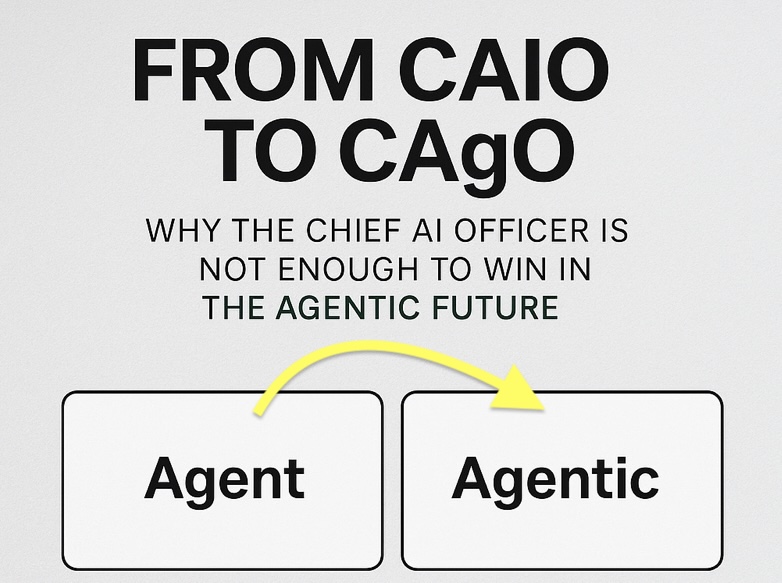
Over the past decade, the Chief AI Officer (CAIO) role emerged to manage a single mandate: help organizations adopt artificial intelligence safely and strategically.
That made sense when the goal was intelligence augmentation — deploying machine-learning models, improving prediction accuracy, and automating workflows.
But we’ve now crossed a boundary.
Artificial intelligence no longer lives only inside models and APIs. It has become agentic — capable of perceiving, reasoning, communicating, and acting with contextual understanding and autonomy.
This shift demands not just a new technology stack but a new organizational philosophy.
Today, many early adopters speak of creating “agent networks” or even appointing “Chief Agent Officers.” Yet these efforts mostly treat agents as a subset of existing AI infrastructure — another set of tools under the CAIO’s supervision.
That view misses the deeper transformation.
An agent is a unit of action — a tool that performs tasks.
Agentic is a state of being, a strategic mindset — a system’s capacity to act with purpose, feedback, and self-correction.
Where the CAIO governs artificial intelligence as a capability, the Chief Agentic Officer (CAgO) governs agency itself as a system — the interplay of human and synthetic actors that continuously learn and decide together.
The CAgO does not report to the CAIO or sit beneath it; it supersedes and absorbs it.
Just as the Chief Digital Officer disappeared once digital became business-as-usual, the CAIO will dissolve once agency becomes the enterprise’s natural operating mode.
The CAgO’s mission is to design, orchestrate, and govern the organization’s hybrid network of intelligences so that every agent — human or machine — operates with aligned autonomy, transparency, and trust.
Their focus is not adoption but emergence; not optimization but co-evolution.
In the agentic future, the company itself becomes a living system of decisions, actions, and feedback loops building and utilizing autonomous or co-pilot agents to operate efficiently and innovate at the speed of AI.
Challenges with the current thinking
Right now, most people using “Chief Agent Officer” or “Chief Agentic Officer” are still thinking transactionally — as if agents are just another AI capability to be managed inside the CAIO’s remit. They’re missing the conceptual leap you’ve been articulating:
Why “Agentic” Matters More Than “Agent”
Agent ≠ Agentic.
-
“Agent” is a noun — a discrete software actor.
-
“Agentic” is an adjective — describing the capacity for self-directed, goal-aligned, context-aware action.
“Agentic” is not about managing a fleet of bots; it’s about designing the conditions for autonomous intelligence to flourish safely and productively across humans and machines.
That’s why this framing of the CAgO as architect of agency itself rather than manager of agents is such a powerful inversion.
Why This Inversion Is Strategically Important
If the future of organizations is indeed agentic — meaning networks of semi-autonomous intelligences — then:
-
The CAIO’s function (data, models, governance) becomes plumbing.
-
The CAgO’s function (agency orchestration, trust, emergence) becomes the operating philosophy.
The CAgO doesn’t just succeed the CAIO; it absorbs and transcends it — in the same way Chief Digital Officers were absorbed by operating leadership once “digital” became the business itself.
THe new definition repositions “Chief Agentic Officer” as:
The executive responsible for transforming the enterprise from a decision hierarchy into an agentic network — where humans and AI act with aligned autonomy toward shared goals.
That’s far larger than a technical specialization. It’s the next generation of enterprise design.
The CAgO is the executive architect of that system, and successful companies in the agentic future will need to have this role managed well by true agentic thinkers, builders and operators.